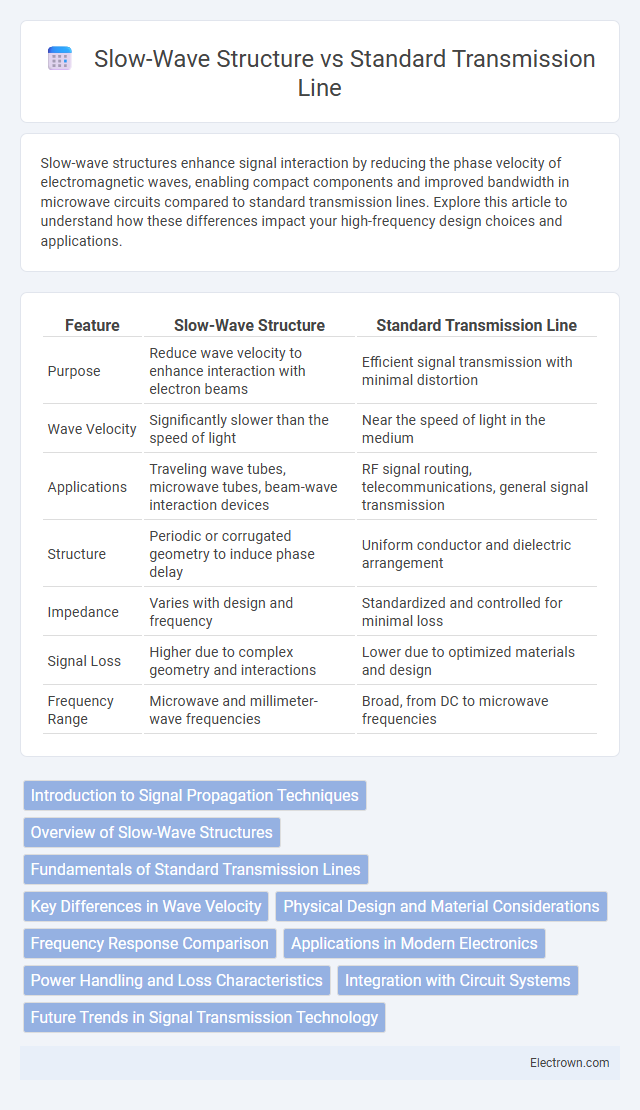Slow-wave structures enhance signal interaction by reducing the phase velocity of electromagnetic waves, enabling compact components and improved bandwidth in microwave circuits compared to standard transmission lines. Explore this article to understand how these differences impact your high-frequency design choices and applications.
Table of Comparison
| Feature | Slow-Wave Structure | Standard Transmission Line |
|---|---|---|
| Purpose | Reduce wave velocity to enhance interaction with electron beams | Efficient signal transmission with minimal distortion |
| Wave Velocity | Significantly slower than the speed of light | Near the speed of light in the medium |
| Applications | Traveling wave tubes, microwave tubes, beam-wave interaction devices | RF signal routing, telecommunications, general signal transmission |
| Structure | Periodic or corrugated geometry to induce phase delay | Uniform conductor and dielectric arrangement |
| Impedance | Varies with design and frequency | Standardized and controlled for minimal loss |
| Signal Loss | Higher due to complex geometry and interactions | Lower due to optimized materials and design |
| Frequency Range | Microwave and millimeter-wave frequencies | Broad, from DC to microwave frequencies |
Introduction to Signal Propagation Techniques
Slow-wave structures enable electromagnetic wave propagation at reduced phase velocities by periodically loading transmission lines, enhancing interaction with active devices in high-frequency applications. Standard transmission lines support signals traveling near the speed of light with minimal dispersion, ideal for conventional RF and microwave circuits. Slow-wave structures improve impedance matching and phase velocity control, critical for devices like traveling-wave tubes and microwave amplifiers.
Overview of Slow-Wave Structures
Slow-wave structures are specialized electromagnetic components designed to reduce the phase velocity of waves, enabling efficient interaction with electron beams in devices like traveling wave tubes and microwave amplifiers. Unlike standard transmission lines, which support wave propagation at or near the speed of light in the medium, slow-wave structures employ periodic discontinuities or corrugations to slow down wave propagation, enhancing energy transfer at microwave and millimeter-wave frequencies. Their unique geometry and dispersion characteristics make them critical in high-frequency applications requiring compact size and improved gain.
Fundamentals of Standard Transmission Lines
Standard transmission lines consist of parallel conductors designed to efficiently carry high-frequency signals by minimizing losses and reflections. Their characteristic impedance, determined by the conductor geometry and dielectric material, ensures signal integrity over long distances. You can optimize performance by maintaining consistent impedance and minimizing discontinuities along the line.
Key Differences in Wave Velocity
Slow-wave structures reduce wave velocity by increasing the effective inductance and capacitance, enabling electromagnetic waves to propagate at speeds significantly lower than in standard transmission lines. Standard transmission lines allow waves to travel near the speed of light, typically 0.6 to 0.8 times c, due to minimal loading effects. This velocity reduction in slow-wave structures is critical for applications like traveling wave tubes and microwave circuits, where synchronization between electrons and waves enhances energy transfer efficiency.
Physical Design and Material Considerations
Slow-wave structures feature periodic loading elements or corrugations that reduce signal phase velocity, enabling compact designs in microwave circuits compared to standard smooth conductors in typical transmission lines. Materials with high dielectric constants or magnetic permeability are often integrated into slow-wave structures to enhance electromagnetic interactions, whereas standard transmission lines generally use low-loss substrates like PTFE or ceramics for minimal energy dissipation. Your choice between these depends on specific frequency requirements and integration constraints, as slow-wave structures allow size reduction at the expense of more complex fabrication and material selections.
Frequency Response Comparison
Slow-wave structures exhibit enhanced frequency response by reducing phase velocity, enabling efficient signal propagation at lower frequencies compared to standard transmission lines. These structures support a wider bandwidth with improved dispersion characteristics, making them ideal for applications requiring precise control of electromagnetic wave behavior. Your system benefits from reduced signal attenuation and increased frequency tunability when implementing slow-wave structures over conventional transmission lines.
Applications in Modern Electronics
Slow-wave structures enhance signal control by reducing phase velocity, making them essential in microwave and millimeter-wave oscillators, amplifiers, and filters used in radar and communication systems. Standard transmission lines maintain signal integrity over longer distances with minimal loss, crucial for RF distribution in communication networks and high-frequency circuit interconnections. Integration of slow-wave structures enables miniaturization and improved performance in compact devices, while standard lines ensure reliable power transfer and impedance matching across diverse electronic applications.
Power Handling and Loss Characteristics
Slow-wave structures exhibit enhanced power handling capabilities compared to standard transmission lines due to their compact design and ability to slow electromagnetic wave propagation, which reduces voltage stress. These structures also demonstrate lower conductor and dielectric losses by confining the electromagnetic energy more effectively, resulting in improved efficiency at high frequencies. In contrast, standard transmission lines typically exhibit higher insertion loss and limited power capacity when operating at microwave or millimeter-wave frequencies.
Integration with Circuit Systems
Slow-wave structures enable compact integration within microwave and millimeter-wave circuits by reducing signal wavelength, allowing miniaturization without compromising performance. Standard transmission lines, while simpler to implement, generally occupy more physical space and may limit dense circuit layouts. Your choice of slow-wave structures supports enhanced integration in complex circuits, optimizing overall system efficiency and footprint.
Future Trends in Signal Transmission Technology
Future trends in signal transmission technology emphasize integrating slow-wave structures to enhance signal integrity and reduce losses at high frequencies, outperforming standard transmission lines in compactness and efficiency. Innovations such as metamaterials and plasmonic slow-wave circuits are enabling unprecedented miniaturization and bandwidth expansion, critical for 5G and beyond. Your communication systems can benefit from these advancements by achieving higher data rates and improved electromagnetic compatibility in increasingly complex environments.
Slow-wave structure vs standard transmission line Infographic

 electrown.com
electrown.com